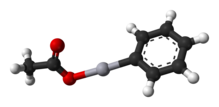Phenylmercury acetate

| |

| |
| Names | |
|---|---|
| Systematic IUPAC name
Phenylmercurio acetate[citation needed] | |
| Identifiers | |
3D model (JSmol)
|
|
| 3662930 | |
| ChEBI | |
| ChEMBL | |
| ChemSpider | |
| ECHA InfoCard | 100.000.484 |
| EC Number |
|
| 83357 | |
| KEGG | |
| MeSH | Phenylmercuric+acetate |
PubChem CID
|
|
| RTECS number |
|
| UNII | |
| UN number | 1674 |
CompTox Dashboard (EPA)
|
|
| |
| |
| Properties | |
| C8H8HgO2 | |
| Molar mass | 336.742 g·mol−1 |
| Melting point | 148 to 151 °C (298 to 304 °F; 421 to 424 K) |
| Hazards | |
| Safety data sheet | Oxford MSDS |
EU classification (DSD) (outdated)
|
|
| R-phrases (outdated) | R25, R34, R48/24/25, R50/53 |
| S-phrases (outdated) | (S1/2), S23, S24/25, S37, S45, S60, S61 |
Except where otherwise noted, data are given for materials in their standard state (at 25 °C [77 °F], 100 kPa). | |
| Infobox references | |
Phenylmercuric acetate is an organomercury compound. This compound was formerly used as a preservative in paints,[1] and as a disinfectant.[2] When applied to the leaves of plants, it is an antitranspirant.[3]
Applications[]
Phenylmercuric acetate (PMA) has been used against fungal activity in agriculture and in leather processing and has been known to work well. PMA has also been used as an additive in eye-drops and paint in order to preserve them, as a disinfectant, and as a catalyst in polyurethane systems.[4][5] In the 1950s–1970s, PMA was used as a catalyst in the 3M Tartan brand polyurethane flexible floors that were commonly found in school gymnasiums.[5] School officials worried that mercury vapor was being released into air above the surface of these floors. They had to be carefully removed since mercury is such a toxic heavy metal.
Findings[]
The study on PMA as an anti-fungal is the most studied topic for this compound. It has been found that plants treated with PMA transpired more due to the retarded stomatal closure in the plants. Day-time reductions in transpiration by PMA greatly exceed night-time increases in water loss. PMA stunts stomatal closures as well as openings.[6] Research has found that PMA may plausibly decrease the absorbency of guard cell membranes to solutes, thereby retarding all stomatal movements that are osmotically prompted.[6]
Hazards[]
PMA can cause Contact Urticaria Syndrome (CUS). Contact urticaria refers to a wheal-and-flare response occurring on the application of chemicals to intact skin. A wheal-and-flare response is a skin eruption that may follow injury or injection of an antigen. It is characterized by swelling and redness caused by a release of histamine. The reaction usually occurs in three stages, beginning with the appearance of an erythematous area at the site of injury, followed by development of a flare surrounding the site; finally a wheal forms at the site as fluid leaks under the skin from surrounding capillaries.[7] CUS has been categorized as an immediate hypersensitivity reaction with IgE (a type of anti-body) playing a crucial role in its pathogenesis.[8] Investigations dealing with CUS seem to suggest that a percentage of urticarias encompass a contact mechanism.[8]
See also[]
References[]
- ^ Simon, Matthias; Jönk, Peter; Wühl-Couturier, Gabriele; Halbach, Stefan (2006). "Mercury, Mercury Alloys, and Mercury Compounds". Ullmann's Encyclopedia of Industrial Chemistry. doi:10.1002/14356007.a16_269.pub2. ISBN 978-3-527-30673-2.
- ^ Siebert, Jörg; Harke, Hans-Peter (2009). "Disinfectants". Ullmann's Encyclopedia of Industrial Chemistry. doi:10.1002/14356007.a08_551.pub2. ISBN 978-3-527-30673-2.
- ^ Moreshet, S. (1975). "Effects of Phenyl-Mercuric Acetate on Stomatal and Cuticular Resistance to Transpiration". New Phytologist. 75 (1): 47–52. doi:10.1111/j.1469-8137.1975.tb01369.x. JSTOR 2431139.
- ^ Geier, J.; Lessmann, H.; Uter, W.; Schnuch, A. (2005). "Patch testing with phenylmercuric acetate". Contact Dermatitis. 53 (2): 117–8. doi:10.1111/j.0105-1873.2005.0650d.x. PMID 16033409. S2CID 42906373.
- ^ a b Beaulieu, Harry J.; Beaulieu, Serrita; Brown, Chris (2008). "Phenyl Mercuric Acetate (PMA): Mercury-Bearing Flexible Gymnasium Floors in Schools — Evaluation of Hazards and Controlled Abatement". Journal of Occupational and Environmental Hygiene. 5 (6): 360–6. doi:10.1080/15459620802017425. PMID 18365889. S2CID 43701302.
- ^ a b Xu, Y.; Zhao, D.; Gao, C.; Zhou, L.; Pang, G.; Sun, S. (2012). "In vitro activity of phenylmercuric acetate against ocular pathogenic fungi". Journal of Antimicrobial Chemotherapy. 67 (8): 1941–4. doi:10.1093/jac/dks133. PMID 22514262.
- ^ Maibach, H. I.; Johnson, H. L. (1975). "Contact Urticaria Syndrome: Contact Urticaria to Diethyltoluamide (Immediate-Type Hypersensitivity)". Archives of Dermatology. 111 (6): 726–30. doi:10.1001/archderm.1975.01630180054004. PMID 1137416.
- ^ a b Torresani, Claudio; Caprari, Elisabetta; Manara, Gian Carlo (1993). "Contact urticaria syndrome due to phyenylmercuric acetate". Contact Dermatitis. 29 (5): 282–3. doi:10.1111/j.1600-0536.1993.tb03574.x. PMID 8112079. S2CID 46255307.
- Organomercury compounds
- Phenyl compounds